Big Data Offers Novel Insights for Oncolytic Virus Immunotherapy
- PMID: 26861383
- PMCID: PMC4776200
- DOI: 10.3390/v8020045
Big Data Offers Novel Insights for Oncolytic Virus Immunotherapy
Abstract
Large-scale assays, such as microarrays, next-generation sequencing and various "omics" technologies, have explored multiple aspects of the immune response following virus infection, often from a public health perspective. Yet a lack of similar data exists for monitoring immune engagement during oncolytic virus immunotherapy (OVIT) in the cancer setting. Tracking immune signatures at the tumour site can create a snapshot or longitudinally analyse immune cell activation, infiltration and functionality within global populations or individual cells. Mapping immune changes over the course of oncolytic biotherapy-from initial infection to tumour stabilisation/regression through to long-term cure or escape/relapse-has the potential to generate important therapeutic insights around virus-host interactions. Further, correlating such immune signatures with specific tumour outcomes has significant value for guiding the development of novel oncolytic virus immunotherapy strategies. Here, we provide insights for OVIT from large-scale analyses of immune populations in the infection, vaccination and immunotherapy setting. We analyse several approaches to manipulating immune engagement during OVIT. We further explore immunocentric changes in the tumour tissue following immunotherapy, and compile several immune signatures of therapeutic success. Ultimately, we highlight clinically relevant large-scale approaches with the potential to strengthen future oncolytic strategies to optimally engage the immune system.
Keywords: immune; immunology; immunotherapy; large-scale; oncolytic; screen; virus.
Figures

References
Publication types
MeSH terms
LinkOut - more resources
Full Text Sources
Other Literature Sources

